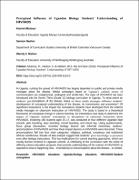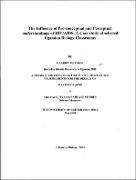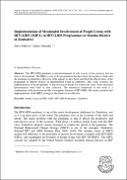| dc.contributor.author | Namazzi, Elizabeth | |
| dc.date.accessioned | 2017-02-14T13:11:28Z | |
| dc.date.available | 2017-02-14T13:11:28Z | |
| dc.date.issued | 2015-07 | |
| dc.identifier.citation | Namazzi, E.B., 2015. Ugandan students' perspectives on the spread and prevention of hiv/aids: cultural practices and education (Doctoral dissertation, University of British Columbia). | en_US |
| dc.identifier.uri | http://hdl.handle.net/2429/54250 | |
| dc.description.abstract | My study investigated perspectives that underlie Ugandan high school students’ understandings of the spread and prevention of HIV/AIDS and how they influenced by cultural practices. I adopted an interpretive case study approach that employed mixed methods, guided by the sociocultural and practice theoretical frameworks. Data were collected on students from seven select schools in central Uganda over 12 weeks. The students participated in the study by completing an adopted HIV/AIDS knowledge questionnaire with a transformed scale from True/False to Likert before and after experiencing HIV/AIDS lesson instructions.
The questionnaire served as a stimulus to evocation of the students’ perspectives. These perspectives were extracted from the questionnaire data using Principal Component Analysis. Results revealed five key perspectives: Perceptual and behavioural risks associated with proximity to HIV/AIDS victims; Hygienic practices; Behavioural/practice causes and transmission of HIV/AIDS; Predictive, preventive and transmissive knowledge of HIV/AIDS; and Naïve notions of prevention and treatment of HIV/AIDS. These perspectives were further interrogated through qualitative methods including classroom observation and focus group interview/discussions. After HIV/AIDS-focused lessons, a similar analysis on the after-lesson questionnaire data also revealed that underlay students’ understandings of the spread and prevention of HIV/AIDS. Three of the pre-lesson perspectives persisted while two (Hygienic practices and Behavioural/practice causes and transmission of HIV/AIDS) collapsed, with two new ones (Taboo-like prescriptions of knowledge of infection) emerging in the after-lesson experience analysis. Also, a realization emerged among the students of the greater risk of HIV/AIDS infection if they subverted the cultural norms. It became noteworthy that the students communicated their understandings metaphorically, which often conveyed unscientific understandings about the spread and prevention of HIV/AIDS. The study’s findings have critical implications for policy and the way curricula and instruction are interpreted and enacted in the classroom. | en_US |
| dc.language.iso | en | en_US |
| dc.publisher | The University of British Columbia, Vancouver | en_US |
| dc.subject | Spread of HIV/AIDS | en_US |
| dc.subject | Prevention of HIV/AIDS | en_US |
| dc.subject | Uganda HIV/AIDS | en_US |
| dc.subject | HIV/AIDS Ugandan Student Perspective | en_US |
| dc.subject | HIV/AIDS Cultural Practices and Education | en_US |
| dc.title | Ugandan students' perspectives on the spread and prevention of HIV/AIDS: | en_US |
| dc.title.alternative | cultural practices and education | en_US |
| dc.type | Thesis | en_US |




